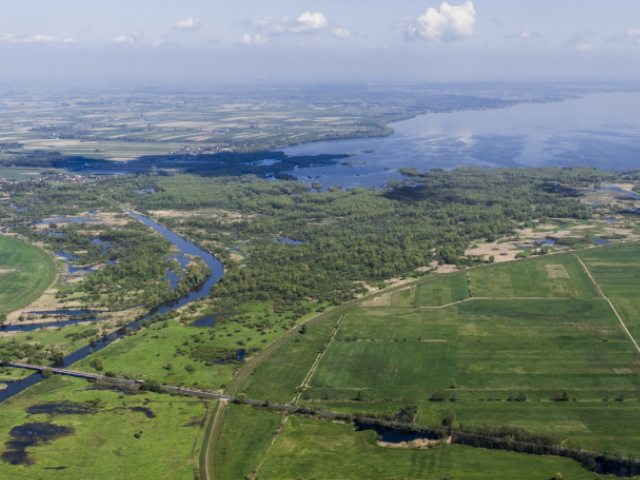Stop Flooding in Poznań. Public consultations of the draft updated FRMP
On 10 March, the public consultations of the drafts of the updated flood risk management plans (uFRMP) for the catchment area of the Oder were held in Poznań. The capital of Greater Poland is the second, after Gorzów Wielkopolski, venue in the water region of the Warta, where the experts meet those interested in flood-protection aspects. The draft of the updated FRMP provides for the total of 44 activities in the region. This number includes two major hydro-engineering projects as well as modernisations and repairs of the existing structures and facilities. The subsequent town where the consultation debate will be held is Kalisz.
At present, the public consultations are the key stage of the developed flood risk management plans. “Currently, we are in the second planning cycle. Our experts draw from the experience acquired when developing the first FRMPs. Together with the water management plans and the plan of combating drought effects, they contribute to the comprehensive structuring of the water management situation in Poland, carried out by Wody Polskie. Public consultations are of immense importance within those processes. The water region of the Warta and, in broader terms, the Greater Poland, require a specific strategy concerning flood-protection activities. Prognosticating the activities to minimise flood hazard, we try to counteract drought effects equally efficiently”, said before the meeting Marek Gróbarczyk, Secretary of State in the Ministry of Infrastructure, responsible for the aspects of water management and investments in the maritime and water sector.
Dangerous floods all the time
The water region of the Warta is an example of synergy of the draft uFRMP and the plan of combating drought effects (PPSS) in the form of numerous activities, including e.g. retention-related ones, aimed mostly at retaining water where it falls to use those resources reasonably in dry periods. An example of such activities is e.g. Wielowieś Klasztorna reservoir. The effects of the warming climate are not only long-term droughts, as it is popularly believed, but also the increased hazard of heavy rainfall. As the dry soil does not absorb water, its passage to rivers is much faster and, more and more often, violent. This is aggravated by paved towns and cities and higher development of flood-endangered areas. All that makes the floods a significant hazard for people and their belongings, the economy and the cultural heritage. The map of the preliminary flood risk assessment for the water region of the Warta indicates several dozen locations where the floods have occurred and where they may still be an actual threat.
New projects and modernisations of the existing ones
Construction of Wielowieś Klasztorna reservoir on the Prosna river is the most important activity designed in uFRMP for the region. The project, with the cost estimated to exceed PLN 1 billion, is to alleviate the drought effects and to prevent floods on the Prosna and the Warta. It will protect the town of Kalisz in particular. The improved flood-protection safety in the valley of the Warta river will be possible thanks to the construction of Golina polder in the poviat district of Konin (the cost of more than PLN 406 million). It is to be created in the territory of three communes, including Golina, Rzgów and Stare Miasto, and will cover close to 2.7 thousand ha. For the commune of Golina this will be as much as 1/4 of its area. The planned activities include the ones connected with the water level monitoring systems, e.g. construction and improvement of the local flood alert systems and the development of the monitoring system, early warning and programming of flood hazards. They include also tasks connected with the modernisation of the hydro-engineering facilities in Jeziorsko reservoir. This largest storage reservoir, situated at the junction of the Greater Poland and Łódź voivodeship (the area of more than 42 km2 and the volume of more than 200 million m3), is close to 40 years old and requires modernisation and repairs. uFRMP provides for numerous modernisations of the reservoir hydro-engineering structures, including the weir modernisation. The continued tasks include modernisations of the flood embankments, including the left-bank embankment of the Warta in the commune of Pyzdry, the right-bank embankment of the Prosna in the commune of Pyzdry, the left-bank flood embankment on Rumin polder in the commune of Stare Miasto and the left-bank flood embankment of the Warta in the village of Rumin. Within the tasks implemented by Wody Polskie, Regionalny Zarząd Gospodarki Wodnej in Poznań, the plan provides for the alteration, vertical enlargement and expansion of the flood embankments of the Kucelinka canal in Częstochowa.
Plans for 6 years
The flood risk management plans are developed for 6 years. At present, they are updated for the first time. They include the most important activities concerning the safety of residents of the threatened areas. The public consultations concerning the drafts of the updated FRMP, announced by the Minister of Infrastructure and coordinated by Państwowe Gospodarstwo Wodne Wody Polskie, started on 22 December 2020 and will last until 22 June this year. The comments and requests have already been submitted. Consultation meetings take place simultaneously. They will be held in as many as 28 towns and cities in Poland. The debates in February, as well as those in March and April, have been and will be carried out on-line. This may change when the pandemics-related restrictions are alleviated or removed. Then, the meetings will be held in the traditional form. Registration for a specific meeting starts close to three weeks before the appointed date. All the information is published on an ongoing basis in the news on www.stoppowodzi.pl. This is where you can find the drafts of the updated FRMP as well.

